Nixeus VUE 30: 30" 2560x1600 IPS Monitor Review
by Chris Heinonen on August 20, 2013 6:00 AM ESTTested using the Leo Bodnar lag tester, I measured 29.23ms of lag with a 1080p signal on the VUE 30. TO use the Leo Bodnar I average the three areas of the screen; top, middle, and bottom, that it can provide data for. With the VUE 30 the Top and Middle were both really low, at 21.6ms and 27.5ms, but it jumped up to 38.6ms at the bottom. I usually see variations of around 7-8ms between the areas, or roughly half the 16.7ms it takes to move between frames, but not a spread of 6ms and then 11ms.
Despite that weird measurement, I didn’t see any tearing or anything else that might be an issue when using the Nixeus for gaming. I’ll just chalk it up to some slightly strange behavior with the scaler and its timing, but not something that I could actually see a problem with. Note also that lag might be lower running at the native 2560x1600, but I can't directly compare that with most other displays as they lack support for that resolution.
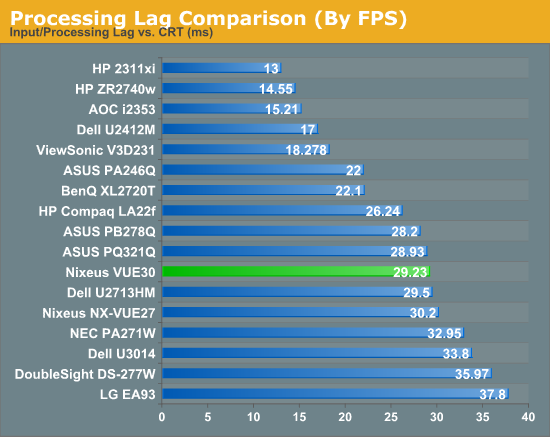
Power use is not a good area for the Nixeus. It is rated for < 130 watts of power consumption on the specs, but my unit managed to use over 150 watts at peak brightness. Since the peak brightness was also almost 75 cd/m2 below the specs, that is a large difference there in the power measurements. A white screen also uses less energy than a black screen with an LCD typically, so I’m not sure what would provide a power measurement that low while running at maximum brightness. Most likely Nixeus is rating power use by how much the display requires and not accounting for the efficiency of the power brick; 85% efficiency at 130W would give us 153W, which is close to what I'm seeing, but it's still quite a bit higher than a modern LED backlit display.
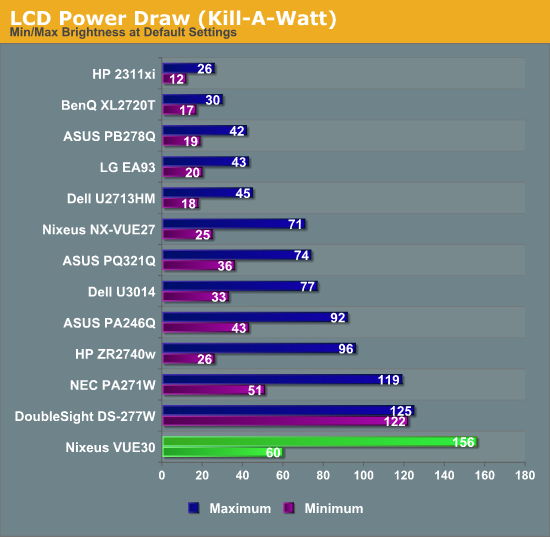
Going down to minimum brightness drops the power use to 60 watts, which is much more reasonable. Using my formula to get candelas per square inch per watt, the Nixeus came in dead last among the displays I have tested. All of the 30” displays do poorly here, as their more complex backlighting systems use a lot more power, but the Nixeus is the worst offender.
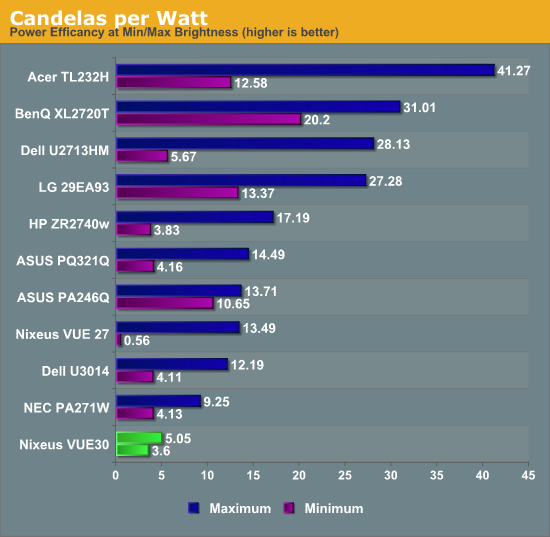
Running the Nixeus profile through Gamutvision, we see 103% coverage of the AdobeRGB gamut. This falls short of some other displays, but still is full coverage and as we saw it works pretty well when in AdobeRGB mode.
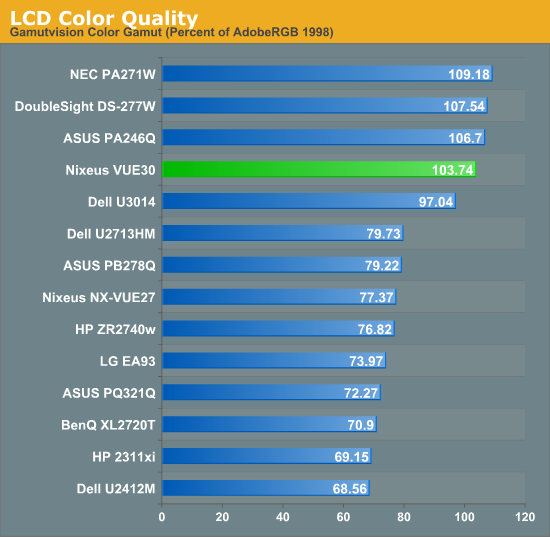
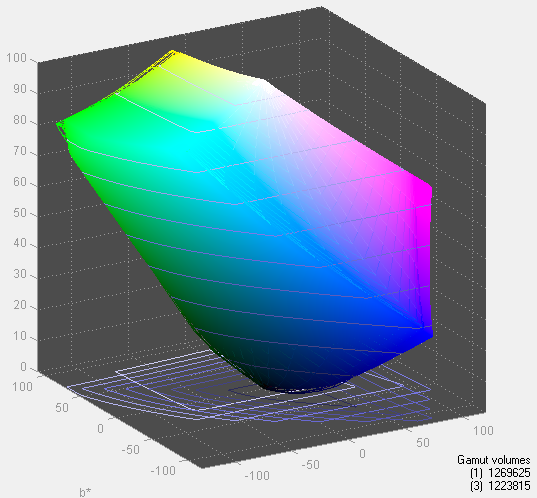


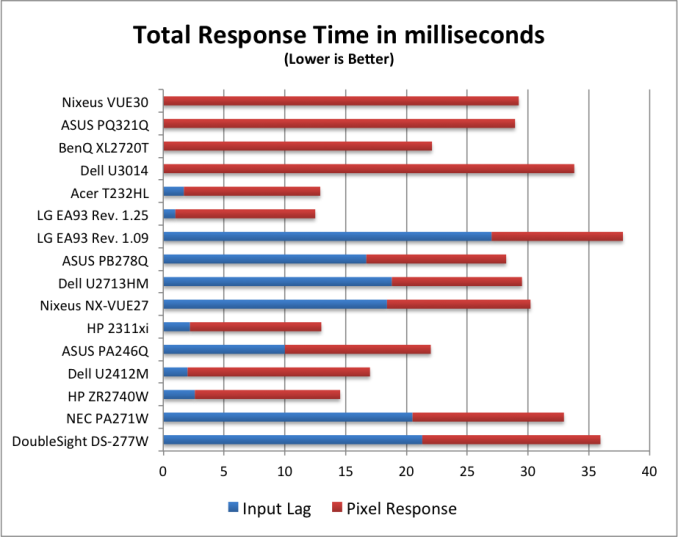








95 Comments
View All Comments
cheinonen - Tuesday, August 20, 2013 - link
I'm finishing up a review of a 27" Monoprice display now that should run next week.blackoctagon - Thursday, August 22, 2013 - link
What about the overclockable 27-inch IPS screens, Chris? They can be sourced locally (from US) these days so no need to acquire one from Korea anymore. God knows there's been enough obsession about them during the past 12-18 months...and yet we still don't have truly professional reviews of themrepoman27 - Tuesday, August 20, 2013 - link
Can we please stop the silly trend of referring to all displays as [vertical resolution] & "p"? The resolutions and aspect ratios of computer displays are not governed by the ATSC or DVB, and none of these panels are intended to be driven in an interlaced mode. At best the "p" just sits there conveying no useful information, at worst it causes the writer to omit actually useful information.[horizontal resolution] & "x" & [vertical resolution] is better, and likely preferable to the rather forgettable initialisms such as "WQXGA". If you are talking about a display with an ATSC or DVB defined resolution and want to use the "p" nomenclature, at least include the maximum refresh rate, since this will definitely be a concern with the initial wave of UHDTV panels.
blackoctagon - Tuesday, August 20, 2013 - link
You're right of course, but typing 1440p is a lot quicker than 2560X1440. Not to mention the fact that pretty much everyone knows (or should know) what 1080p/1440p/1600p is shorthand for in the context of computer monitors.piroroadkill - Tuesday, August 20, 2013 - link
I agree.The p is totally hopeless information. Pointless trend. Even worse, when people have described 1920x1200 tablets as "1080p" or "Full HD". I don't want a 1920x1080 screen necessarily, but a 1920x1200 one is a more compelling ratio.
Impulses - Tuesday, August 20, 2013 - link
Alluding to the new Nexus 7 there? I had a chuckle when I saw Google use both terms on the official Play store page, right alongside the 1920x1200 listed res. It's like the average consumer can't even be counted on to remember more than one number anymore or even assume larger = better (probably why 4K has emerged as a label, anything more technically accurate would just go in one ear and out the other).DanNeely - Wednesday, August 21, 2013 - link
4k emerged as a term years ago in high end professional video circles because all but one of the resolutions used were 4096 pixels across; the aspect ratio was varied solely by changing the vertical resolution. From there it just trickled down; we geeks read about it on gadget blogs/etc and lusted after stuff that would support it while costing less than our homes and gradually popularized it as the next big thing. Meanwhile, and unsurprisingly the TV people settled on the slightly smaller quadHD standard since it has less implementation/back compatability issues.blackoctagon - Thursday, August 22, 2013 - link
I think you're being overly fussy. Even John Carmack casually uses the 'p' when describing the resolution of non-TV displays (just heard him do so on the QuakeCon keynote)7beauties - Tuesday, August 20, 2013 - link
Since this is an IPS panel, it probably goes without saying that its refresh rate is just 60Hz. The response time of 7ms is borderline if you're a gamer. What's most disappointing to me is that it has CCFL backlighting, making the display heavier, hotter, thicker, and less power efficient. Most current LCD's use the newer LED backlighting, so this is the LCD equivalent of paying luxury price for a car that's carburetered. I'll hold out for when OLED's take hold and become affordable. Thank you.DanNeely - Tuesday, August 20, 2013 - link
Except for the most expensive sort, LED backlighting cannot match a *good* CCFL for color gamut. While the lack of an sRGB mode limits the VUE 30 somewhat their backlight choice indicates they're going for the pro market where color accuracy is more important than the equivalent of an hours pay/year in extra power use or an increase in thickness that no one but a silly fanboi would care about.